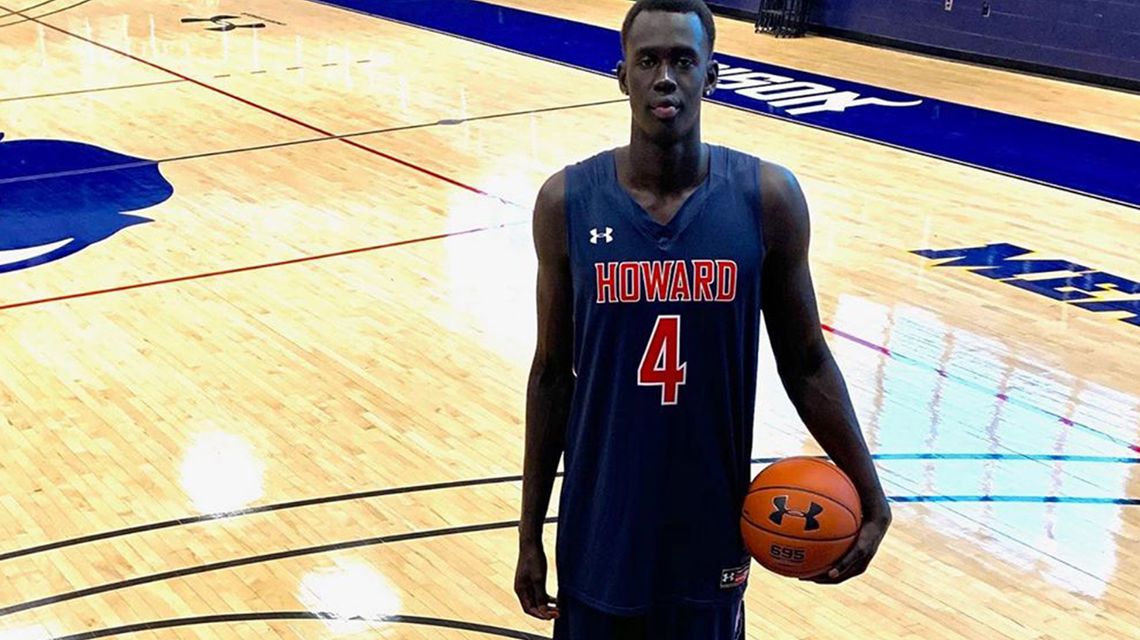
Maker’s HBCU commitment was for the culture
PHOENIX (BVM) – July 9 is South Sudan Independence Day, and a special day for five-star prospect Makur Maker.
Less than a week after Maker became the highest-rated recruit to ever commit to a historically black college or university (HBCU), the 6-foot-11 big man appeared on ESPN’s “First Take” to explain his commitment to Howard University.
5-star prospect Makur Maker commits to Howard amid offers from Kentucky, Oregon, UCLA and USC 🔥 @brhoops
Bringing change to the next generation: "I need to make the HBCU movement real so that others will follow." pic.twitter.com/hiW771uZaz
— Bleacher Report (@BleacherReport) July 3, 2020
Despite offers from blue-chip programs like Kentucky, UCLA and USC, Maker began to seriously consider the HBCU route following his 2017-18 season at Orange Lutheran.
“I took a look at Howard University and just HBCUs in general, and what I realized is that it’s culture; it’s history,” Maker said on First Take.
The Bison went just 4-29 and 1-15 in conference play last season, but there’s much more at stake here for Maker.
The generated revenue from Maker’s presence at Howard that would be funneled back into Black communities, and the inspiration this unprecedented move will give to future elite prospects are at the forefront of his mind.
“I definitely think it’s going to generate a lot of wealth toward our people,” Maker said. “It’s the players that make the TV exposure, it’s the players that make these deals. Going to an HBCU is definitely something for top recruits to consider seriously.”
On your side my boy let’s shock the world!!! @MakurMaker https://t.co/XJ4JrgFmTH
— Mikey Williams (@619PRESIDENTIAL) July 3, 2020
Maker hopes fellow California native Mikey Williams continues the trend, and it appears early on that the rising sophomore might do just that.
Arguably the country’s best 15-year-old basketball player set social media ablaze on a June 2 morning, and hinted at a potentially monstrous culture shift with just eight words.
“Going to an HBCU wouldn’t be too bad,” Mikey Williams, the San Ysidro star and No. 3 player in the Class of 2023, said on Twitter.
Even before scoring 77 points – which broke the CIF-San Diego Section and state freshman scoring record – in a December win, Williams was on college radars for years due to his dunking ability. After just one season of prep hoops, the 6-foot-2 guard has offers from Kansas, UCLA, Tennessee, Arizona and others, but recent social media posts suggest the freshman phenom is considering a path similar to that of Maker’s.
Rather than turning pro after high school or taking the one-and-done route at a powerhouse program, Williams plans to consider an HBCU, which are never destinations for blue chip prospects like him or Maker.
“This has been a thought for years; this didn’t just recently pop up in my head,” Williams wrote in an Instagram post the next day further explaining his tweet. “Why does it always have to be the big universities? Why does it always have to be the big names? We are the reason that these schools have such big names and such good history.”
Although the HBCU landscape has changed in recent decades, it was once a hotbed of the NBA’s best players during the 1960s and ‘70s. Basketball legends like Charles Oakley, Willis Reed, Rick Mahorn and Earl Monroe starred at HBCUs before their storied NBA careers.
Current NBA players such as Robert Covington and Kyle O’Quinn are modern proof of the HBCU-to-NBA pipeline, but the majority of NBA talent comes from Power 5 schools.
Despite claims that elite talent can’t receive the same experience or level of competitiveness at an HBCU, Williams acknowledges that name-brand college programs aren’t the only pathways to the NBA.
“What a lot of top-level athletes don’t understand is, if you’re a pro, then you’re a pro no matter what college you go to,” Williams wrote in an Instagram post. “Even if you don’t go to college, if you’re a killer, you are going to kill anywhere. Not enough people speak on things like this and I’ve been meaning to do so and put some word out, but I figured this would be the perfect time to do it.”
The NCAA brought in $1 billion of revenue during the 2016-17 school year – most of which was generated by the Division I Men’s Basketball Tournament, or March Madness – all the while refusing to pay college athletes and prohibiting them from profiting off of their name, image or likeness.
A major reason why the HBCU route appeals to Williams, much like Maker, is that he knows the revenue he generates during his college career would stay within the Black community.
“I just wanted to let everybody know that I am riding for my people,” Williams said on Instagram. “I’m 10 toes behind the black community. Any way I can help or make a change in the black community, best believe I am going to do that.”
Williams sparkled as a freshman for the Cougars, averaging 29.9 points, 6.7 rebounds and 4.9 assists per game. That type of production typically excludes HBCUs that view Williams as unattainable from contention, but that was until his flurry of powerful social media posts.
Just hours after his tweet circulated the internet, Tennessee State offered Williams a scholarship without even seeing him play in person. Norfolk State and Texas Southern did the same, and by the next afternoon, the prolific 6-foot-2 guard had piled up offers from nearly a dozen HBCU programs.
Now, HBCUs like Grambling State, Hampton and Howard are beside schools like Oregon, USC and Arizona State on Williams’ offer list.
Williams could send more shock-waves throughout the NCAA with a unique move for someone of his status, and alter the future of HBCUs in the process. As his recruitment picks up over the next three years, the 15-year-old knows exactly the kind of power he possesses.
“Only God knows what the future holds, but when that time does come that I have to narrow my schools down to whatever number it is, there will be multiple HBCUs on that list,” Williams said.
“And they won’t just be there for show.”







